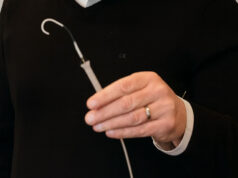
Transcatheter tricuspid valve replacement in the setting of trans-tricuspid pacemaker leads without extraction or re-replacement can be performed safely with a low risk of complications, a study published in JACC: Cardiovascular Interventions has found. The study, authored by Jason H Anderson (Mayo Clinic, Rochester, USA) and colleagues, concludes that transcatheter valve replacement for valve-in-valve or valve-in-ring implantation offers a safe alternative to surgical valve replacement in the setting of pacemaker leads.
“Tricuspid valve surgery in the current era carries a high operative risk and a poor long-term prognosis,” Anderson and colleagues write, prompting interest in transcetheter alternatives to repeated surgical intervention.
To date, the safety and feasibility of transcatheter tricuspid valve replacement in patients with previously placed transvenous pacemaker leads, particularly right ventricular leads, has been limited to case reports and a single centre case series. Consequently they sought to examine the incidence and types of pacemaker lead complications encountered in a large multicentre registry cohort of patients undergoing the procedure.
Data were collected through the Valve-in-Valve International Database registry, composed of patients with acquired and congenital heart disease who underwent transcatheter tricuspid valve replacement following tricuspid valve repair (valve-in-ring) or replacement (valve-in-valve) surgery.
The primary outcome was lead-related complications during transcatheter tricuspid valve replacement. Lead complications including lead fracture and dislodgement were assessed at the time of the procedure. Lead integrity was assessed via threshold and impedance testing immediately after transcatheter tricuspid valve replacement and during follow-up. Procedural outcomes and post-implantation prosthetic valve function were evaluated for comparison between subgroups.
Anderson and colleagues report that overall, 335 patients underwent cardiac catherisation for intended transchatheter tricuspid valve replacement, with 329 of these having valves implanted in the tricuspid valve position within a stented surgical bioprosthetic valve (n=301 [91%]), transcatheter valve (n=2 [1%]), annuloplasty ring–supported autograft or stentless replacement valve (n=4 [1%]), or previously repaired tricuspid valve (n=22 [7%]).
Of the 335 patients in the intention-to-treat cohort, 131 (39%) had a pre-existing epicardial (n=70) or transvenous (n=61) pacing system in place. Of 329 implanted patients, 128 had pacing systems (39%), which were transvenous in 58 (18%).
The study team report that patients with epicardial pacing systems were younger, had more prior cardiac surgical procedures, were more likely to have prior bioprosthetic surgical implants, and surgical valve size <29mm, and had a lower incidence of atrial fibrillation or flutter than those without epicardial pacing systems.
In total, 58 patients with transvenous pacing systems underwent transcatheter tricuspid valve replacement. Of these, 27 patients did not have trans-tricuspid valve leads; four had atrial pacing leads; 13 had ventricular leads in the coronary sinus, and 10 had surgically excluded leads implanted between the bioprosthesis and annulus at the time of replacement. Of the 31 patients with leads passing through the tricuspid valve, three had the RV leads extracted prior to transcatheter tricuspid valve replacement, one of whom was converted to an epicardial pacing system, while the other two had the right ventricular leads reimplanted through the TV prosthesis afterwards. In the remaining 28 patients, the right ventricular leads were entrapped between the transcatheter tricuspid valve implant and the surgical valve (n=22) or the repaired tricuspid valve (n=6).
Detailing right ventricular lead outcomes, the study team noted that three of the 28 patients (10.7%) with intentional lead entrapment had documented lead complications. The other 25 patients had intact right ventricular leads without known impairment of lead function through a follow-up period of 15.2 months post-transcatheter tricuspid valve replacement. Three patients died of heart failure, unrelated to the procedure or pacemaker function, during the follow-up period, the study team reports.
In terms of procedural outcomes of patients with transvenous pacing systems that did and did not have right ventricular lead entrapment, the study team notes that these did not differ between the two groups. The median main diastolic valve gradient after transcatheter tricuspid valve replacement was 3mmHg. Two patients who underwent valve-in-ring transcatheter tricuspid valve replacement demonstrated moderate or greater paravalvular regurgitation immediately following valve implantation, neither of whom had a right ventricular lead entrapment.
Discussing the findings, Anderson and colleagues write: “This is the largest analysis to date evaluating the approach and safety of transcatheter tricuspid valve replacement in the setting of prior pacemaker leads. Patients with trans-tricuspid valve pacing leads undergoing transcatheter tricuspid valve replacement with lead entrapment had a low prevalence of immediate procedural complications, with lead dislodgement occurring in only 1 in 28 patients (4%).”
The study team concludes: “In this preliminary study, we found that transcatheter tricuspid valve replacement in the setting of a trans-tricuspid valve pacemaker lead was performed safely, with a low risk for periprocedural complications, offering a transcatheter alternative to redo surgical tricuspid valve replacement with or without lead extraction. Although low, there is a risk for lead failure after transcatheter tricuspid valve replacement, for which ongoing evaluation of the lead threshold and impedance testing should be performed.”










